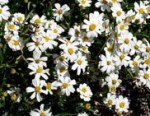 Heat and drought tolerant, this native of the southern Great Plains to Arizona and northern New Mexico makes an excellent plant for rock gardens or border plant in desert gardens especially when massed. The plants are low growing and form rounded clumps with narrow gray leaves and honey-scented white daisy-like flowers with a long bloom season. Butterflies love blackfoot daisies but deer and rabbits do not. Plants thrive in lean, well-drained soil once established. Although blackfoot daisies tend to be short-lived, they readily reseed. The genus name, Melapodium, may come from the Greek words melas meaning black and podion meaning foot and refers to the color of the stem base and root. The common name, blackfoot, is a translation of the botanic generic name. Another the theory about the etymology is that it comes from the thame of the mythological Greek southsayer, Melampus. The specific epithet, leucanthum. comes from the Greek words leukos, meaning white, and anthemon, meaning flower and refers to the white ray flowers.
Heat and drought tolerant, this native of the southern Great Plains to Arizona and northern New Mexico makes an excellent plant for rock gardens or border plant in desert gardens especially when massed. The plants are low growing and form rounded clumps with narrow gray leaves and honey-scented white daisy-like flowers with a long bloom season. Butterflies love blackfoot daisies but deer and rabbits do not. Plants thrive in lean, well-drained soil once established. Although blackfoot daisies tend to be short-lived, they readily reseed. The genus name, Melapodium, may come from the Greek words melas meaning black and podion meaning foot and refers to the color of the stem base and root. The common name, blackfoot, is a translation of the botanic generic name. Another the theory about the etymology is that it comes from the thame of the mythological Greek southsayer, Melampus. The specific epithet, leucanthum. comes from the Greek words leukos, meaning white, and anthemon, meaning flower and refers to the white ray flowers.
Type: Herbaceous perennial
Bloom: Small fragrant daisy-like white flowers 1- 1 ½” across bloom from late spring to fall.
Foliage: Grayish green, silvery leaves are opposite, and linear to lanceolat.
Size: 6-12” H x 12-36” W
Light: Sun; some shade in extreme heat
Soil: Average, dry, well–drained, acidic (less than 7 pH)
Hardiness: Zones 7-11
Care: Cut older plants back by half to maintain compactness.
Pests and Diseases: Root rot in poorly drained soil
Propagation: Seed
Companion plants: Mealycup blue sage (Salvia farinacea), beard-tongues ( Penstemon spp), blazing star (Liatris spicata) , plains zinnia (Zinnia grandiflora), cacti.
